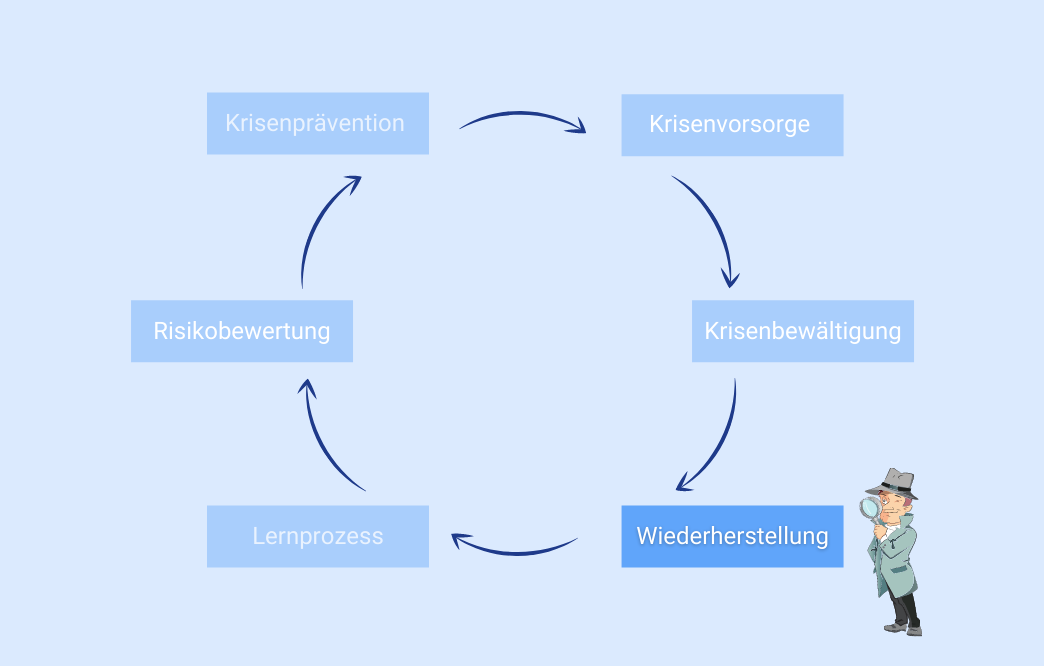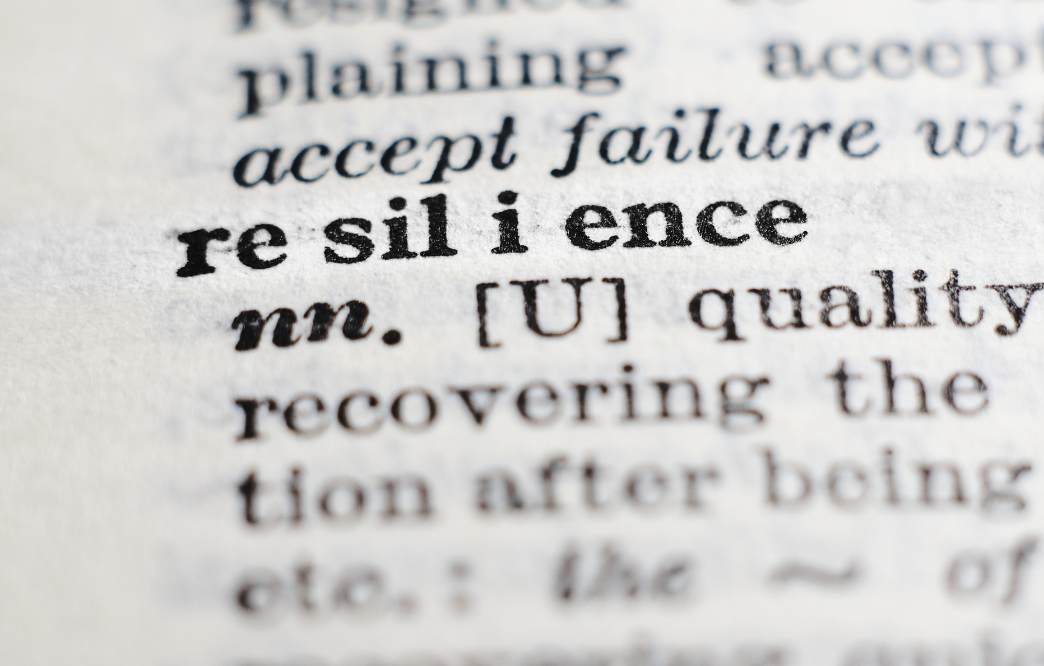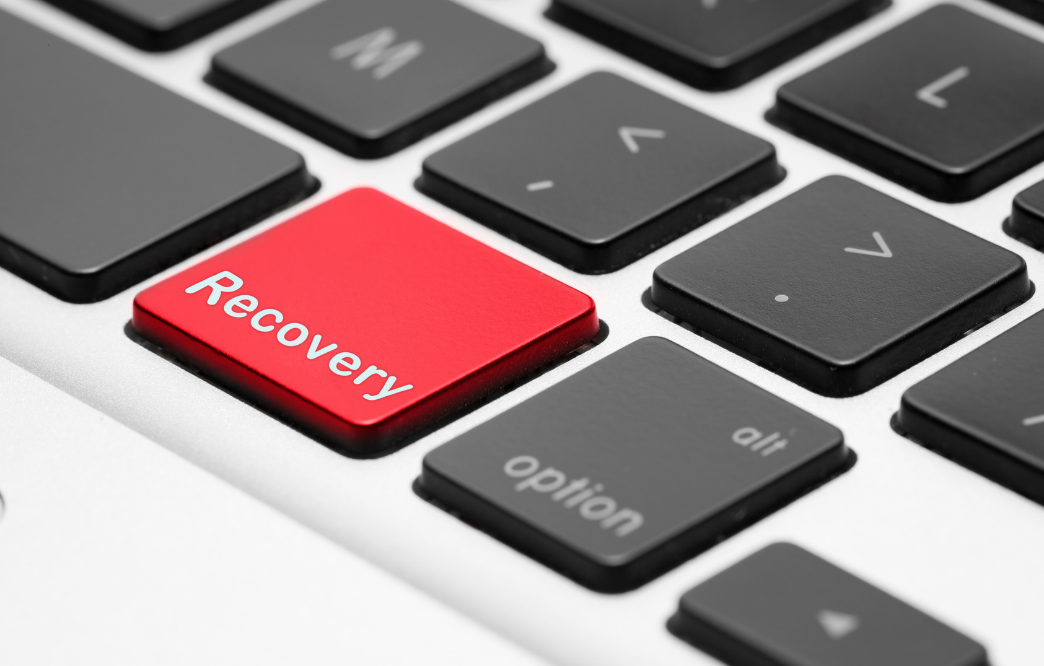Table of contents
Restoring normal operations after a crisis is critical to any organisation’s emergency response and crisis management. Processes need to be robust in order to get the impaired business areas back into operation quickly. This can not only save companies from major damage in an emergency, but can also be beneficial in day-to-day business.
Let’s take a look at what exactly the process of recovery means in the context of crisis management:
Restoration (Recovery)

With regard to disaster management, the United Nations International Strategy for Disaster Reduction UNDRR defines “recovery” as
*“the restoration and, where appropriate, improvement of facilities, livelihoods and living conditions of communities affected by a disaster, including efforts to reduce disaster factors”.
(Source)
In the following, we first devote ourselves to recovery planning, and later to the active recovery phase after crisis management. In this context, we highlight the concept of resilience, from the perspectives of society, technology, economics and psychology.
Recovery planning
Since recovery from a major emergency is a complex, costly and lengthy process, experience-based guidelines and best practices recommend preparing thoroughly. Recovery structures and processes must therefore be well planned and tested in advance. After a crisis event, however, it is not just about getting back to normal, but should be seen as an opportunity to improve resilience in the status quo.
The better the planning, the easier the recovery. The main concept here is the Business Continuity Plan, which describes an organisation’s strategic and tactical ability to prepare for and respond to incidents and operational disruptions so that operations can be maintained at an acceptable level.
One of its core elements is Business Impact Analysis (BIA), which consists of:
- Capture and selection of relevant business processes,
- Damage analysis for process failure,
- Determination of damage classes (financial, reputation, etc.),
- Evaluation of possible consequences for different durations of failure,
- prioritisation of processes and
- Resource considerations.
Resilience as recovery
As we noted in Part 5 of our blog series on crisis preparedness, resilience describes the ability of a system, community or society to withstand, adapt to and recover from the effects of a hazard in a timely and efficient manner, including by maintaining and restoring its essential basic structures and functions.
Here, resilience includes not only protection itself, but also prevention, training, education, research, deterrence, risk-based mitigation, crisis management, recovery and longer-term restoration.
One way to measure resilience is by the level of performance of a system, i.e. whether or not it has been completely disabled. Consequently, reducing the instances of total power failure would increase resilience. In addition, the time, (or money/loss), it takes for an infrastructure or function to fully restore normal operation also plays a role. This is because the faster the recovery of the damaged business processes, the more resilient the system will naturally be.
Societal recovery
Societal, social or community resilience is usually about the issue of adaptive or responsive capacity, recovery of emergency management and self-help capacity in the face of crisis, emergency or disaster.
Indicators to measure baseline levels of societal resilience include: Educational equity, age, transport accessibility, communication skills, language skills, health care, sense of place, political structures, cohesion and trust, social relations, life satisfaction, conflict, power, youth engagement, responses to opportunities to influence change, learning and knowledge, knowledge utility and transfer, learning from experience, participation in decision-making, use of community resources, and stakeholder capacity to act.
But the link between infrastructures and social systems also play a role. Thus, it is argued that it is necessary to link physical systems and human communities in order to measure and improve societal resilience.
Organisational recovery
A common definition of organisational resilience is based on different temporal phases and translates as “a function of an organisation’s overall situational awareness, management of key vulnerabilities and adaptive capacity in a complex, dynamic and interconnected environment “.
But how does an organisation know if it is resilient or not? In the literature on indicators to measure an organisation’s resilience, as well as in national and international standards (especially from the ISO and ANSI family), the focus is primarily on Critical Infrastructures, whose supply chain challenges are related to potential infrastructure failures.
The objective is to measure the ability of an organisation to withstand a disruption in its critical infrastructure facilities and to maintain or quickly restore its functionality. In practice, this is largely done in the form of self-testing. To be resilient, organisations must fundamentally take into account factors such as strong and flexible leadership, an awareness and understanding of their operational environment, their ability to adapt to rapid change, and so on.

Technological recovery
Technological or technical resilience is most commonly referred to in the field of critical infrastructure and is when an infrastructure is able to withstand damage or disruption and can be restored quickly and cost-effectively if compromised. Typical characteristics of critical infrastructure resilience includes: Robustness, redundancy, resourcefulness and rapid recovery, returning to normal as quickly as possible after a disaster.
Recovery can be enhanced, for example, by unplanned maintenance, how easy it is to restart the system, the independence of the system from other systems that may have failed, etc. These characteristics are in turn influenced by several other indicators. For example, unplanned maintenance depends on the availability of maintenance staff and spare parts, or whether the system has been designed to be resilient with regard to unplanned maintenance.
The latter is often referred to as maintainability. For example, if a technical system has already been designed to be resilient, it should be based on modules as much as possible. A technical failure in one part of the system could then be quickly repaired by removing the failed module and replacing it with a new one. Such a system would then be easier to maintain than systems without this feature and could be restored more quickly in the event of a technological failure.
Economic recovery
Economic resilience is broadly about examining the economic consequences of the presence or absence of resilience, with the aim of proposing and promoting resilience measures, including economic or financial recovery. The Darwinian approach characterises economic resilience as follows: Systems that cannot adapt, like species, have no chance of survival.
In economic terms, the focus is on the dynamics of technological innovation and the need for adaptive behaviour in companies and markets. The following aspects play a role here:
- the extent of regional economic diversification,
- the ability to substitute and save necessary inputs,
- the commercial and industrial improvisation capacity, and
- the time needed to regain capacity or lost revenues.
A distinction is made between static economic resilience and dynamic economic resilience. The former describes the ability of a unit or system to maintain function (e.g. to continue producing), the latter the speed with which a unit or system recovers to reach a desired state.
Further, economic resilience can be divided into three domains:
- microeconomic (individual enterprise or household),
- meso-economic (single industry or market) and
- macroeconomic (combination of all economic units).
The latter overlaps significantly with the focus on community or societal resilience. The idea is to develop economic resilience indicators for all three levels. Together they form a kind of overall index to characterise economic resilience.
Psychological recovery
Psychological resilience concerns the ability to recover on a personal level. This is all closely related to the debate on psychological recovery and the research that focuses on post-traumatic stress disorder (PTSD). PTSD can result from a variety of situations, not only for the victims of a crisis, but also for the emergency responders working in the field.
Psychological resilience focuses on how to measure whether or not a person is psychologically resilient, particularly to PTSD. The indicators that most often lead to low resilience to disasters include lack of social support, previous trauma, loss of resources, human loss and poor physical or mental health.
Interventions to improve these conditions or to target the most vulnerable groups can increase psychological resilience.

Conclusion
The process of recovery focuses, on the one hand, on recovery planning, which is not about the actual recovery phase, but rather about preparation, i.e. the elements that need to be in place to facilitate post-crisis recovery. Secondly, recovery concerns resilience, which is concerned with the central question of how systems can recover quickly after a failure - at the societal, organisational, technological, economic and psychological levels. Find out what lessons can ultimately be learned from a crisis in the 8th and final part of our blog series
Image sources: GroupAlarm, Canva Pro

